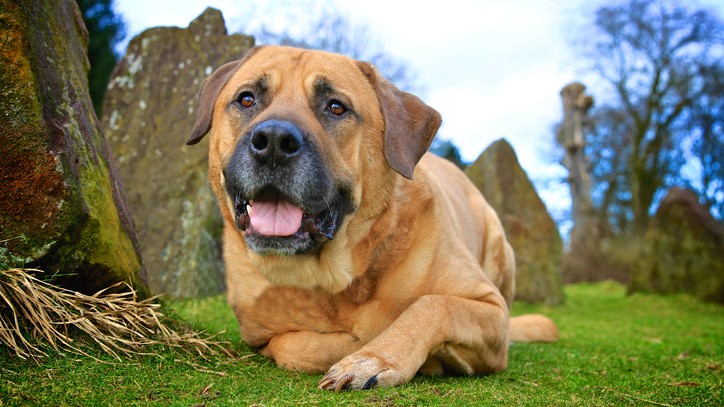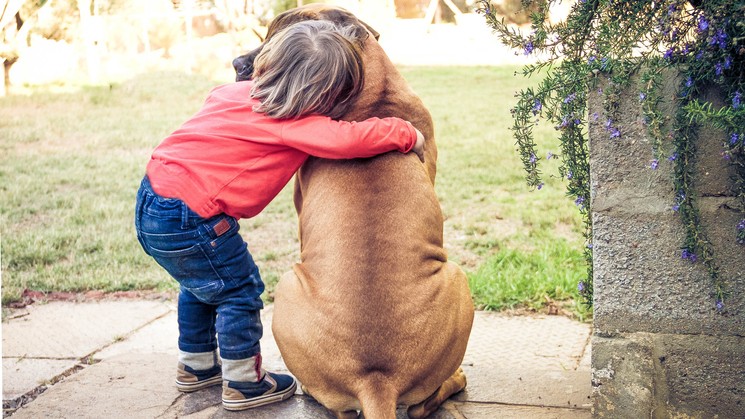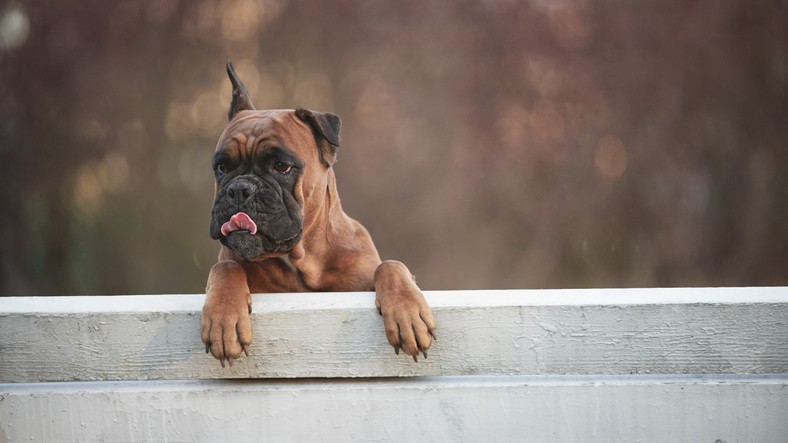Bullmastiff: Breed profile
The Bullmastiff may not look particularly friendly but these gentle souls are a joy to have around

Bullmastiffs have long proven to be wonderful, loyal, and protective family companions. Although the Bullmastiff is often mistaken for a Pitbull – with all of the associations that (unfairly) brings – so you're certainly unlikely to see intruders hanging around for too long with this breed in the house.
Once known as the Gamekeeper's Night Dog, Bullmastiffs were bred to help large-estate owners to keep poachers at bay, and can be traced as far back as 1860. Most of their genes are those of the Mastiff – some 60% – while the rest comes from the 19th century Old English Bulldog. This is what gives them their name.
Over time, the breed has become far less aggressive than it once was, but these dogs still stand tall, proud, and independent, which is all part of their charm. Bullmastiffs were deemed pure by the English Kennel Club in 1924, and recognized 10 years later by the American Kennel Club. Since then, they've become very popular pets, and are also full of surprises, as we're about to find out.
How much exercise does a Bullmastiff need?
Life expectancy: 8–10 years
Average weight: Male: 130lbs/59kg Female: 119lbs/54kg
Bullmastiffs are one of the laziest, most low-maintenance breeds around, and you'll likely find they're more likely to want to relax around your home than pester you to venture outside. Even so, it's vitally important that you take them for an hour's walk each day. That way, you will ensure they remain fit and healthy, while also helping maintain their muscle tone.
Ideally, you should split the walks across two or three daily sessions, being sure to avoid excessive heat because of the breed's short muzzles. If possible, find a secure area where you can let your Bullmastiff off the lead. This will also give you an opportunity to mentally stimulate your fur baby with games of fetch, perhaps, or some tug-of-war.
That said, it's a good idea to keep these sessions short to avoid putting excess pressure on fragile joints. Likewise, you'll need to be extra careful with Bullmastiff puppies, because there is a risk that excessive exercise can pummel their joints and harm their development and growth. By sticking to moderate exercise, though, and looking out for early signs of fatigue, you should be able to reduce their excess energy with few problems.
Are Bullmastiffs easy to train?
Suitable for: Anyone who wants a protective family guard dog
Not suitable for: Anyone who would gross out over drool
Temperament: Powerful, calm, loyal
Shedding: Low
Bullmastiffs are receptive to training, but you'll only find it 'easy' if you have prior experience with large dogs. Novice owners are known to struggle with a Bullmastiff's strong temperament mainly because the independent-minded breed is no pushover. Without firm obedience training, Bullmastiffs will seek to gain the upper hand, so you have to be confident, consistent, and fair. It's also vital that training starts very early – literally from the moment the first paw hits the carpet.
Get the best advice, tips and top tech for your beloved Pets
Without positively-reinforced reward-based training, the breed can become disruptive. It's important, then, that you make clear what you're expecting of them, and position yourself as their leader. Since they are natural guard dogs, Bullmastiffs also need to be immediately socialized around animals and people. That way, they will be on their guard when they perceive a threat, but otherwise recognize and react well to friendly behavior.
Are Bullmastiffs good with kids?

Being calm, docile, and easy going, Bullmastiffs are known for being patient around children. You just need to be wary of their size and powerful build, particularly if you have babies and toddlers – after all, you won't want a Bullmastiff to accidentally knock into a child, because this could lead to an injury.
With that in mind, it's always a good idea to supervise children when they're around a Bullmastiff. If nothing else, it will allow you to spot any signs that the breed is becoming too excited or unhappy. You should also teach kids how to behave around dogs. This will significantly lower the chance of encountering problems.
What do Bullmastiffs eat?
As puppies, Bullmastiffs need a balanced diet rich in protein and fat. To aid their growth and development, you'll also need to keep stepping up the amount of puppy food you give them each day, maybe even reaching between eight and 12 cups spread across three or four meals by the time they are 18 months old.
When they are adults, they can switch to the a food containing less protein and fat. By this stage, however, the main concern will be preventing your dog from becoming obese, which is easier said than done, because Bullmastiffs are among the most prone to putting on weight. To help, you should stick to a regular schedule, and ensure they exercise before rather than after meals to prevent bloat. Go easy on the treats by ensuring they don't exceed 10% of their overall diet.
Do Bullmastiffs bark a lot?
It may surprise you to learn that Bullmastiffs don't actually bark all that much. They'll only really make a noise if they feel danger around them, are left alone for a prolonged period of time, or are greeting someone new. For the rest of the time, they will be rather quiet and calm, which is likely to be great news for your neighbors, not to mention your ears.
Are Bullmastiffs aggressive?

Bullmastiffs are known as gentle giants, but they can be aggressive if they feel their family are in danger. They can also be aggressive if they haven't been properly socialized, and have a particular problem with other dogs of the same sex.
It's why training and early socialization is a must with this most territorial of breeds. Certainly be wary if a Bullmastiff is growling or showing teeth. They don't tend to bite, but if they do, they could cause a serious injury.
Do Bullmastiffs shed a lot?
Amount of shedding: Low
Easy to groom?: Yes
General health: Poor
Potential for weight gain: Moderate
Not really. Bullmastiffs have a short coat, and if you keep on top of it every week or so it's likely you won't find very many hairs on the couch or carpet. What you do need to watch out for, though, is drooling. It's pretty excessive, and happens throughout the day, dripping from their mouth and getting everywhere. A lot of your time is going to be spent wiping it up, and you may find you have a towel practically glued to your hand. The good news, however, is that the saliva will protect their teeth and gums, and keep them cool. Maybe invest in a bib.
Wisdom Panel Breed Discovery DNA Kit | Amazon
Not sure exactly what breed your dog is? This kit screens for 365+ breeds – because knowing every detail about your dog helps you understand how best to care for them.
Bullmastiff health problems
Bullmastiffs suffer from a number of health problems. Some, such as heat exhaustion and heatstroke, can be avoided by simply not taking them for exercise when it too hot outside. Obesity can be kept in check by not giving them an abundance of food and ensuring they are remaining active.
Some health issues are harder to prevent, though. As a brachycephalic breed, their shorter faces mean they are prone to breathing difficulties, and they suffer from Brachycephalic Obstructive Airway Syndrome. Other common ailments include elbow and hip dysplasia, problems with their eyelids, and Gastric Dilation Volvulus – a life-threatening condition where the stomach fills with air and twists.
Sadly, Bullmastiffs also have a short lifespan. It is heartbreaking to lose a dog after eight to 10 years, so do bear that in mind.
Should I get a Bullmastiff?
It depends. If you want an effective guard dog, you will be well served by a Bullmastiff. Likewise, if you want a great family dog, a Bullmastiff will slot well into your lives – so long as you keep an eye on very young children. The main problem arises if you have pets. Bullmastiffs don't tend to get on well with other animals, especially cats and other dogs. You may also want to steer clear if you are house-proud, and don't want drool all over your furnishings.
Here’s more information on types of mastiffs, plus more bullmastiff facts you haven’t heard yet

David Crookes has been a journalist for almost 30 years and he has written for a host of magazines, newspapers, websites and books including the World of Animals Annual, BBC Earth, Live Science, The Independent and Tom’s Guide.
Born in England, he lives with two cats but he’s also keenly interested in the differences between the huge number of dog breeds – in fact, you can read many of his breed guides that he’s written in collaboration with vets here on PetsRadar.
With a lifelong passion for technology, too, he’s always on the lookout for useful devices that will allow people to keep their pets happier and healthier, and provide them more time to spend together.
David has a degree from Durham University, as well as postgraduate diploma in journalism from the University of Central Lancashire.

